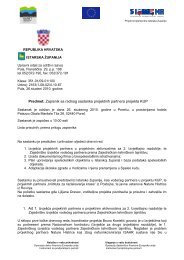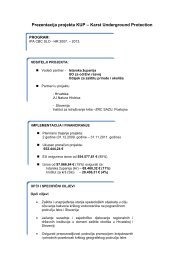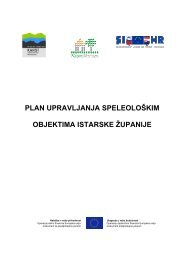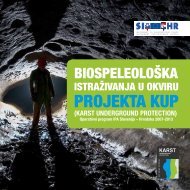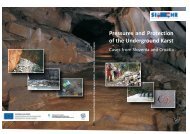prvi hrvatski speleološki kongres - KARST underground protection
prvi hrvatski speleološki kongres - KARST underground protection
prvi hrvatski speleološki kongres - KARST underground protection
Create successful ePaper yourself
Turn your PDF publications into a flip-book with our unique Google optimized e-Paper software.
Facing this situation, CWEPPS made it its mission to act in favour of the<br />
<strong>protection</strong> and the preservation of this particular environment and the values<br />
associated with it.<br />
CWEPSS : Origin and historical background<br />
CPSS, later to become CWEPSS was created by Belgian cavers and scientists<br />
in 1970, becoming the first association in the world with such a goal. The initial<br />
objective was to protect the environment, <strong>underground</strong> waters and, by extension, all<br />
karstic phenomena from destruction and pollution.<br />
In the beginning…campaigns were organized to clear pollution. Teams<br />
removed litter from depressions and sinkholes. Pollution cleaning weekends were<br />
organised in cooperation with the towns and Civil Protection. This led to litter being<br />
collected from the caves. Some pollution clearing has been carried out more recently<br />
in cooperation with caving clubs.<br />
Purpose<br />
CWEPSS wants to contribute towards the sustained <strong>protection</strong> and<br />
management of karstic sites and subterranean waters, whilst favouring speleological<br />
exploration and scientific research in a generally unknown environment.<br />
Actions<br />
Since 1970, CWEPSS has been coordinating or taking part in various "actions<br />
in the field " such as clearing pollution, managing and preserving some caves,<br />
hydrological studies, biodiversity inventories, conservations programs… It is<br />
officially consulted over some land use and management problems in karstic areas, for<br />
some conservation issues and in cases of possible conflicts with limestone quarries. It<br />
has been asked by the Walloon government to provide a network of 100 subterranean<br />
reserves in order to ensure the <strong>protection</strong> and long term conservation of that very<br />
particular ecosystem.<br />
It carries out public awareness campaigns on the topic of “Subsoil waters and<br />
endangered caves” to the attention of schools, of local and regional authorities, of<br />
river contracts.<br />
Longer term, it aims at a durable <strong>protection</strong> of the sites and subsoil waters by<br />
requesting classifications, the introduction of the statute of Underground Cavity of<br />
Scientific Interest for certain outstanding caves and an adequate position for the<br />
karstic zones in the regional planning charts. Its objective is to contribute to a taking<br />
into systematic account of the characteristics, the wealth and the vulnerabilities of the<br />
karstic areas in regional planning and to promote scientific research and a consensual<br />
and durable management for the subterranean environment by including the cavers.<br />
Through different campaigns, it tries to raise the opinion interest (in priority, in<br />
schools, with local and regional authorities) on the challenge of sustainable and long<br />
term management of groundwater resources and on the vulnerability of the<br />
subterranean environment.<br />
All these actions are made possible because of the support and the<br />
participation of a large group of cavers and members who provide precious local<br />
information concerning karstic areas and on the 1200 caves actually known in<br />
Belgium. This information is stored in a geo-referenced database. This quite unique<br />
38



